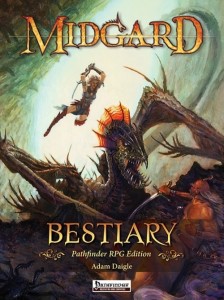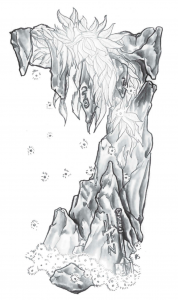 As you may know from my review of Kobold Quarterly #21, I am out of the loop when it comes to Open Design. I’ve been asked to review the Pathfinder edition of the Midgard Bestiary, developed by Adam Daigle, which counts as my first exposure to the setting. That puts a great deal of responsibility on the book.
As you may know from my review of Kobold Quarterly #21, I am out of the loop when it comes to Open Design. I’ve been asked to review the Pathfinder edition of the Midgard Bestiary, developed by Adam Daigle, which counts as my first exposure to the setting. That puts a great deal of responsibility on the book.
Gazing Into the Abyss
What do you do when you find yourself confronted with a book of monsters? I imagine, like me, your first reaction is to flip through it and see if anything catches your eye. If art is important in any RPG book, it is most important in a bestiary.
Immediately the alseid grabs my attention. It is like a centaur, but instead of human and horse, the combination is elf and stag. Springing up out of his long hair are a pair of antlers. Baba Yaga’s horsemen are the first “monsters” in color I encounter. Most of the bestiary is sepia pages and black-and-white artwork. The splashes of full-color artwork are nice.
I dislike the blood hag and broodiken. Their appearance does not inspire me and I know I will give them a pass. Fortunately there are many other monsters whose appearance delights me: Bone collector, cavelight moss, dire weasel, salt golem. The list goes on. The Bestiary passes the first trial.
One thing I wish were present in the book, and all monster books in general, is an artist credit for each entry written along the side margin or some other unobtrusive place. This makes it easier to look up a particular artist’s other work when you like what you see. The pieces aren’t always signed, initialed, or otherwise marked.
Unspeakable Names

Cavelight Moss, by Hugo Solis
What is it with monster books and crazy names? Admittedly they can be fun to make if we are the ones making them, and every now and then one really just clicks (Zmey). Yet I find that names like andrenjinyi, cikavak, and stuhac tend to blend into each other in my head. Descriptive names such as child of the briar, dragonleaf tree, roachling, and vapor lynx do wonders for me, even if they might seem less “original” at first blush. Your preferences, of course, may vary. Salt golem to taste.
Monsters Rule
“How are these going to work for my Pathfinder game?” I hear you ask. Pretty well! The Midgard Bestiary contains a fairly standard mix of monster difficulties, with most hanging around the lower CRs, a reasonable number of mid-range ones, and a few power-hitters at the top tiers. That’s pretty good, because let’s face facts: you campaign is not likely to last as long as you’d like, so it helps to have many awesome low-CR monsters to encounter rather than waiting for them all at levels you never get to see. I’m also happy with the variety of plant creatures. That’s a personal thing.
The monsters presented within the pages of the bestiary are well thought-out, and on the whole are interesting without being horrendously overpowered or mind-numbingly mundane. The authors have gone to obvious effort to provide not just rules info but setting detail on the creatures. I’m particularly fond of the little in-world asides that a few of the entries have.
I found the entries detailed enough that I began to get an idea of what Midgard must be like, and yet any of these creatures are easily ported over into another campaign. I already have several ideas. In closing, if you are looking for something different to spice up your game with, I do recommend the beasts, plants, and peoples populating these pages.
Midgard: Bestiary (PFRPG) is available on Paizo.com in both print ($24.99) and PDF ($9.99) editions. It is also offered as a bundle of the two for $25.99.

I think *Adam* Daigle was the developer. At least that’s what the image of the cover says. 😉
-Ben.
Wow. Yes. That is what I meant to write all along! Thanks!